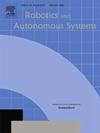Time-bounded planning with uncertain task duration distributions
IF 4.3
2区 计算机科学
Q1 AUTOMATION & CONTROL SYSTEMS
引用次数: 0
Abstract
We consider planning problems where a robot must gather reward by completing tasks at each of a large set of locations while constrained by a time bound. Our focus is problems where the context under which each task will be executed can be predicted, but is not known in advance. Here, the term context refers to the conditions under which the task is executed, and can be related to the robot’s internal state (e.g., how well it is localised?), or the environment itself (e.g., how dirty is the floor the robot must clean?). This context has an impact on the time required to execute the task, which we model probabilistically. We model the problem of time-bounded planning for tasks executed under uncertain contexts as a Markov decision process with discrete time in the state, and propose variants on this model which allow adaptation to different robotics domains. Due to the intractability of the general model, we propose simplifications to allow planning in large domains. The key idea behind these simplifications is constraining navigation using a solution to the travelling salesperson problem. We evaluate our models on maps generated from real-world environments and consider two domains with different characteristics: UV disinfection, and cleaning. We evaluate the effect of model variants and simplifications on performance, and show that policies obtained for our models outperform a rule-based baseline, as well as a model which does not consider context. We also evaluate our models in a real robot experiment where a quadruped performs simulated inspection tasks in an industrial environment.
求助全文
约1分钟内获得全文
求助全文
来源期刊

Robotics and Autonomous Systems
工程技术-机器人学
CiteScore
9.00
自引率
7.00%
发文量
164
审稿时长
4.5 months
期刊介绍:
Robotics and Autonomous Systems will carry articles describing fundamental developments in the field of robotics, with special emphasis on autonomous systems. An important goal of this journal is to extend the state of the art in both symbolic and sensory based robot control and learning in the context of autonomous systems.
Robotics and Autonomous Systems will carry articles on the theoretical, computational and experimental aspects of autonomous systems, or modules of such systems.
 求助内容:
求助内容: 应助结果提醒方式:
应助结果提醒方式:


